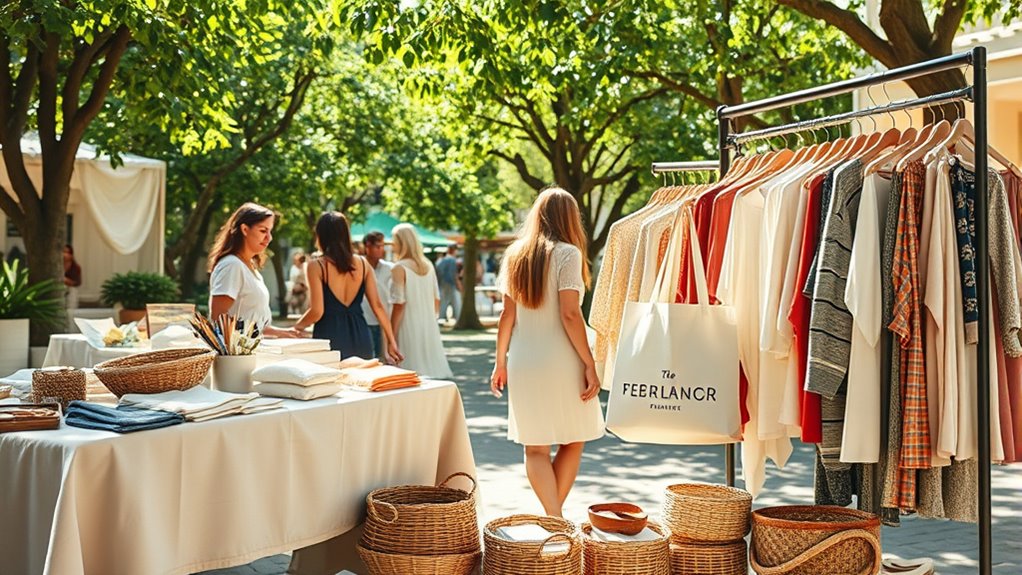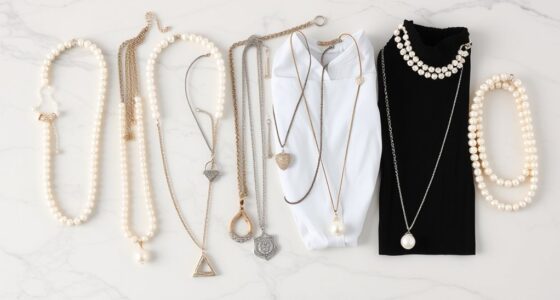To shop ethically, focus on supporting brands that prioritize fair labor practices, transparency, and eco-conscious materials like organic or recycled fabrics. Always look for trusted eco labels such as GOTS or Fair Trade to verify sustainability claims. Choose high-quality, timeless pieces over fast fashion to ensure longevity. Support small, local brands and explore thrift or vintage stores for unique finds. Staying informed about sustainable options helps make better choices—continue exploring to learn more about building a conscious wardrobe.
Key Takeaways
- Research and verify eco-friendly certifications like GOTS, Fair Trade, and OEKO-TEX before purchasing.
- Prioritize high-quality, durable garments made from natural or recycled fibers to ensure longevity.
- Support ethical, small-scale, and local brands that prioritize fair wages and sustainable practices.
- Incorporate secondhand, vintage, or thrifted pieces to promote reuse and reduce waste.
- Make conscious shopping choices by setting budgets, being patient, and choosing versatile, timeless styles.
Understanding What Makes Fashion Sustainable

What exactly makes fashion sustainable? It’s about more than just eco-friendly materials. Sustainable fashion minimizes environmental harm throughout a garment’s lifecycle, from sourcing to disposal. You want brands that prioritize eco-conscious practices, such as using organic or recycled fibers, reducing water and energy consumption, and avoiding harmful chemicals. Fair labor practices matter too; ethical production ensures workers are paid fairly and work in safe conditions. Durability is key—investing in high-quality pieces that last longer reduces waste. Transparency is another sign of sustainability; brands that openly share their processes demonstrate accountability. Additionally, understanding Creative Practice Overview can help consumers recognize culturally respectful and ethically responsible brands and practices, emphasizing the importance of comprehensive approaches to well-being. When you shop sustainably, you’re supporting a system that values environmental health and social responsibility, ultimately helping to reduce the negative impact fashion has on the planet.
Recognizing Certified Eco-Friendly Labels

When you see eco-friendly labels on products, it’s important to understand what they really mean. Certified eco labels are designed to verify that items meet specific environmental standards, but not all labels are equally trustworthy. Always check the certification organization to guarantee the label is authentic and genuinely eco-conscious. Recognizing the video tutorial for reliable information can help you better understand which labels are credible. Additionally, understanding the certification process can empower you to make more informed choices about sustainable fashion. Being aware of common toxins and hazards in non-certified products can further help you avoid items that may be harmful to the environment or your health. Learning about environmental standards can also guide you toward more ethical shopping options. Considering the symbols in dreams related to environmental themes can also inspire more mindful purchasing decisions.
Certified Eco Labels Explained
Ever wondered how to quickly identify products that truly meet eco-friendly standards? Certified eco labels are your best guide. These labels indicate that a product has undergone third-party verification to meet strict environmental and social criteria. Look for well-known labels like Global Organic Textile Standard (GOTS), Fair Trade Certified, or OEKO-TEX Standard 100. Each label has specific standards: GOTS focuses on organic fibers, Fair Trade emphasizes fair wages and working conditions, and OEKO-TEX tests for harmful substances. When you see these certifications, you can trust that the product aligns with sustainable practices. Additionally, using a curling iron on Halloween wigs requires careful attention to avoid damage, highlighting the importance of quality products and proper techniques. Remember, these labels are designed to help consumers make informed decisions quickly, so familiarizing yourself with them makes shopping more efficient and ensures your choices support genuine eco-friendly brands.
Verifying Authentic Certifications
While certified eco labels can guide you toward sustainable choices, not all labels are genuine or trustworthy. To confirm authenticity, start by researching the certifying organization. Reputable labels, like GOTS or Fair Trade, are backed by transparent standards and third-party audits. Check the certification’s website for detailed information about the standards and verification process. Be cautious of vague or overly broad claims, such as “eco-friendly” without specific credentials. Look for official logos on the product tags and verify their legitimacy through the certifier’s platform. Remember, authentic certifications are usually updated regularly, so review the validity date. When in doubt, consult trusted resources or organizations dedicated to sustainable fashion. Verifying certifications ensures your choices genuinely support ethical and eco-conscious brands. Additionally, understanding the Patchology.ORG scientific inquiry behind dreams can help identify false claims and promote more informed decisions.
Prioritizing Quality Over Quantity
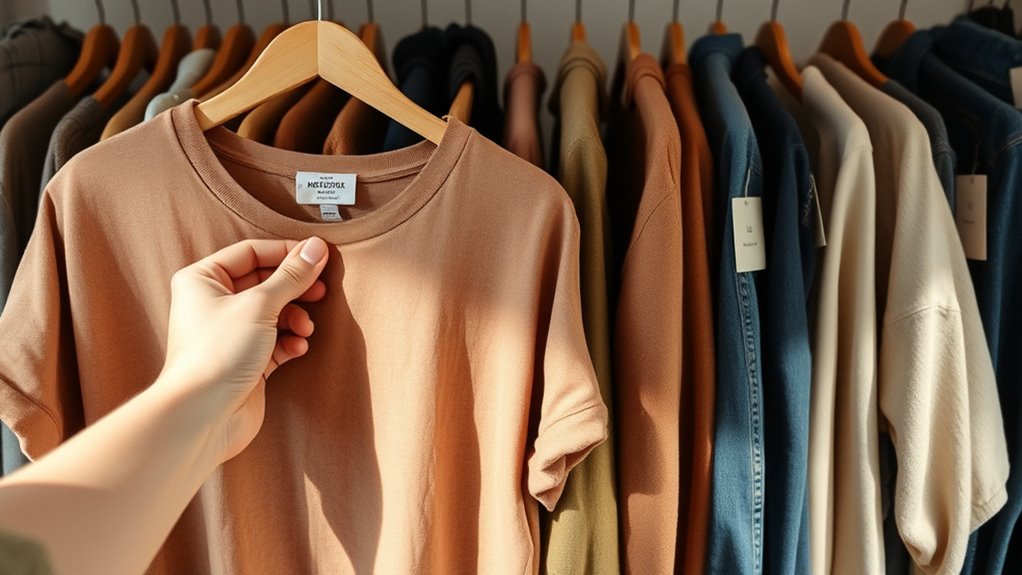
Choosing fewer, higher-quality pieces means your wardrobe becomes more sustainable and long-lasting. Instead of chasing fleeting trends, focus on durable items that stand the test of time. This approach aligns with the clutter-free space philosophy, promoting intentional purchases that reduce waste and support ethical practices. Incorporating sustainable fashion choices into your wardrobe can also reflect your commitment to sustainable and creative choices. Additionally, selecting AI-driven insights can help you make more informed decisions about ethical brands and practices. Leveraging product lifecycle information can further ensure that your clothing choices support environmental and social sustainability.
Durability Over Trends
Prioritizing quality over quantity means investing in durable clothing that lasts instead of chasing fleeting trends. When you choose well-made pieces, you reduce waste and avoid the cycle of fast fashion. Look for items crafted with sturdy fabrics, reinforced seams, and timeless designs. These clothes stand up to regular wear and maintain their appearance longer. Additionally, selecting well-crafted garments can help ensure your clothing maintains its quality over time. By focusing on durability, you ensure your wardrobe remains versatile and sustainable over time. This approach saves you money in the long run, as you won’t need to replace clothing frequently. It also reflects a mindful attitude toward consumption, emphasizing value and longevity over passing fads. When you prioritize quality, you make more ethical choices that benefit both the environment and your wardrobe’s sustainability. Considering vetted products ensures that your clothing choices are safe, effective, and aligned with sustainable standards. Additionally, understanding the costs associated with payment processing can help businesses optimize their financial practices, contributing to overall sustainability.
Fewer, Better Pieces
Have you ever considered how owning fewer, higher-quality pieces can transform your wardrobe? When you focus on quality over quantity, you’ll find yourself with fewer items that last longer and look better. Instead of buying trendy, cheap fast-fashion, invest in timeless pieces made from durable materials. These garments may cost more upfront, but they save you money in the long run and reduce waste. With fewer, better pieces, you’ll spend less time shopping and more time wearing clothing you truly love. Plus, you’ll feel better knowing your wardrobe supports ethical practices and environmentally friendly production. Prioritizing quality helps you build a versatile, sustainable wardrobe that reflects your style and values, making conscious shopping a natural part of your everyday life. Incorporating sustainable production methods can also help you support brands that prioritize ethical manufacturing practices and environmental responsibility. Additionally, choosing pieces with antique or vintage appeal adds unique character and supports sustainable reuse. Focusing on quality control ensures that the garments you select meet high standards of durability and craftsmanship, further supporting your commitment to ethical fashion. Being aware of ethical hacking principles can inspire you to adopt transparent and responsible practices in your purchasing decisions, ensuring your wardrobe choices align with your values.
Supporting Local and Small-Scale Brands
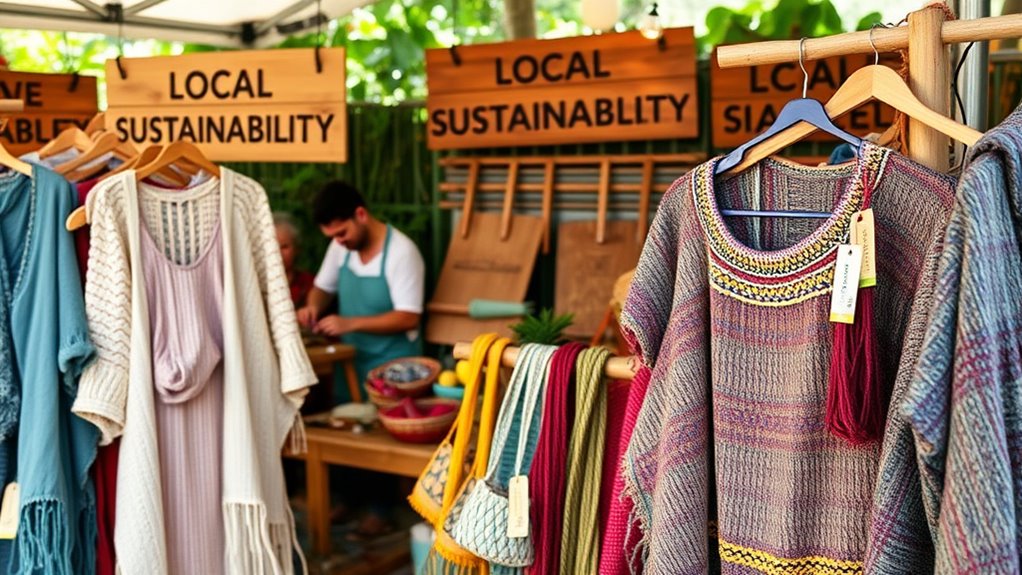
Ever wondered how supporting local and small-scale brands can make a real difference? By choosing these brands, you help keep production local, which reduces the carbon footprint associated with shipping and transportation. Small brands often prioritize ethical practices, such as fair wages and sustainable materials, because they build their reputation on authenticity. When you shop from them, you’re supporting entrepreneurs who are passionate about quality and transparency. Plus, local brands tend to produce limited runs, meaning less waste and fewer unsold items ending up in landfills. Your support encourages innovation in sustainable fashion and strengthens local economies. Additionally, engaging with trailer music techniques can inspire brands to incorporate more compelling storytelling into their marketing efforts. This connection to ethical manufacturing not only benefits the environment but also fosters trust and loyalty among consumers. Ultimately, buying from small-scale brands allows you to make more conscious choices, aligning your wardrobe with your values and fostering a more ethical fashion industry.
Choosing Timeless Styles Over Fast Fashion

Choosing timeless styles instead of fast fashion means investing in pieces that last and remain stylish year after year. When you opt for classic designs, you avoid the constant cycle of trendy, disposable items. This approach reduces waste and guarantees your wardrobe stays relevant longer. To build a timeless wardrobe, focus on:
- Neutral colors that complement any outfit and season.
- Simple cuts and classic silhouettes that never go out of style.
- Quality fabrics like wool, linen, or organic cotton that withstand wear and washing.
Exploring Secondhand and Thrift Shopping
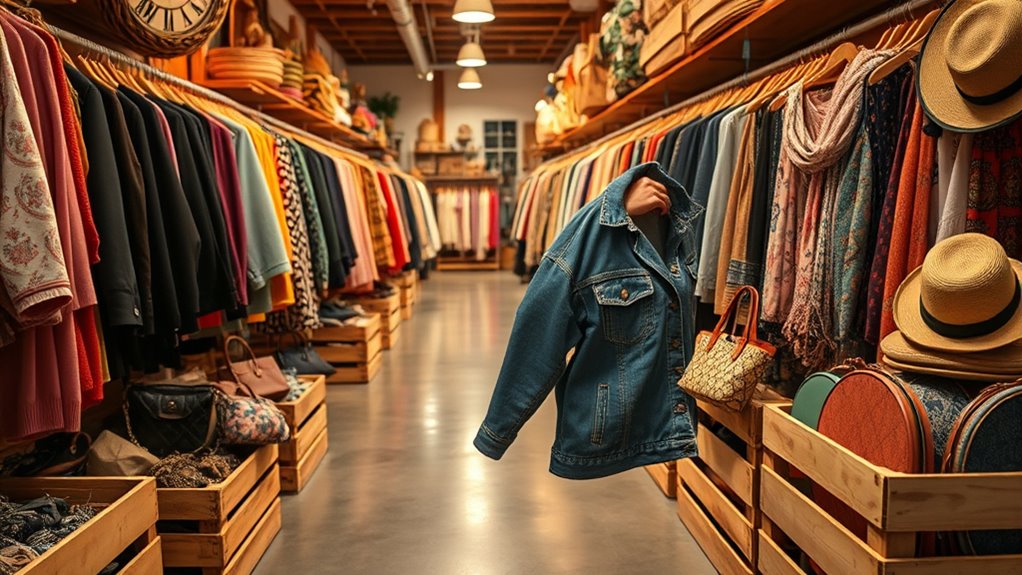
Exploring secondhand and thrift shopping is a practical way to find high-quality, stylish pieces while reducing your environmental impact. You can uncover unique, vintage items that add character to your wardrobe and often cost less than new clothes. Thrift stores, consignment shops, and online marketplaces make it easy to access diverse styles and sizes. Shopping secondhand encourages reuse, preventing garments from ending up in landfills, and diminishes demand for fast fashion, which heavily pollutes the environment. To make the most of your thrift shopping experience, set a budget, be patient, and stay open-minded. With a little effort, you’ll discover sustainable fashion treasures that reflect your personality while supporting eco-friendly practices.
Being Mindful of Materials and Fabrics

Being mindful of materials and fabrics is essential when shopping ethically because the production and disposal of textiles have significant environmental impacts. Some fabrics are more sustainable than others, and choosing wisely can reduce your ecological footprint.
Here’s how you can make better choices:
- Opt for natural fibers like organic cotton, hemp, or linen, which require less water and chemicals.
- Avoid synthetic fabrics such as polyester and nylon, as they shed microplastics and are derived from fossil fuels.
- Look for fabrics made from recycled materials or those certified organic, ensuring eco-friendly farming practices.
Reducing Waste Through Proper Care and Recycling

Taking good care of your clothes helps them last longer, reducing the need to buy new items and cut down waste. Recycling and repurposing garments extend their usefulness and keep materials out of landfills. By being mindful of how you care for and dispose of your clothes, you contribute to a more sustainable wardrobe.
Extend Garment Lifespan
Caring for your garments properly can considerably extend their lifespan and reduce waste. When you follow a few simple steps, you keep clothes looking their best longer, decreasing the need for new purchases. Here are three ways to do that:
- Wash clothes with cold water and gentle cycles to prevent fabric wear and color fading.
- Avoid over-washing; spot clean when possible to reduce unnecessary washing.
- Repair minor damages like loose buttons or small tears instead of discarding the item.
Recycle and Repurpose
Extending the life of your garments through proper care not only keeps them looking good longer but also reduces the amount of textile waste that ends up in landfills. When you’re finished with clothing, consider recycling or repurposing it instead of tossing it out. Many brands and organizations accept old textiles for recycling, turning worn-out fabrics into new products like insulation or cleaning rags. You can also get creative by transforming old pieces into new items—turn a T-shirt into a tote bag or jeans into patchwork upholstery. Donating clothes to charity or thrift stores gives them a second life, helping others and reducing waste. By actively recycling and repurposing, you play a essential role in minimizing environmental impact and promoting a circular fashion economy.
Building a Conscious Wardrobe With Versatile Pieces

Creating a conscious wardrobe starts with choosing versatile pieces that can be mixed and matched for various occasions. Focus on items that are timeless, well-made, and adaptable. This approach reduces the need for excess clothing and supports sustainable shopping.
Building a sustainable wardrobe with versatile, timeless pieces reduces clutter and promotes eco-friendly fashion choices.
Consider these key pieces:
- A classic white shirt – pairs with jeans, skirts, or layered under sweaters.
- A pair of well-fitting jeans – suitable for casual or dressier looks with the right accessories.
- A neutral blazer – adds polish to any outfit and can be dressed up or down.
Staying Informed and Advocating for Ethical Practices

To make truly ethical choices in fashion, staying informed about industry practices is essential. You should regularly research brands’ sourcing, labor conditions, and environmental impact. Follow trusted blogs, join sustainable fashion communities, and read reports from organizations that evaluate brands’ ethics. Advocacy plays a key role—use your voice to support policies promoting fair labor laws and transparency. Share your knowledge with friends and on social media to raise awareness and encourage others to shop responsibly. When you stay updated, you can make better purchasing decisions and hold brands accountable. Your advocacy helps push the industry toward more sustainable and ethical standards. Remember, informed consumers influence change, so stay curious, ask questions, and remain committed to supporting ethical fashion practices.
Frequently Asked Questions
How Can I Verify the Ethical Practices of a Clothing Brand?
You want to verify a clothing brand’s ethical practices, so start by researching their transparency. Check if they share details about their supply chain and labor conditions. Look for certifications like Fair Trade or GOTS, which indicate ethical standards. Read reviews and reports from third-party organizations. Reach out directly with questions about their sourcing and manufacturing processes. This approach helps you make informed, responsible choices.
What Are the Best Online Resources for Sustainable Fashion Information?
Sure, because finding sustainable fashion info online is as simple as a quick click, right? You can start with sites like Good On You, which rates brands’ ethics, and the Ethical Fashion Forum, packed with resources. Don’t forget to check out Greenpeace’s detox campaign for transparency. These tools help you spot eco-friendly brands effortlessly, turning your shopping into a conscious act rather than a reckless scroll through endless pages.
How Do I Identify Environmentally Friendly Dyes and Finishes?
To identify environmentally friendly dyes and finishes, look for brands that openly share their sourcing and production processes. Check labels for certifications like GOTS or OEKO-TEX, which indicate eco-friendly practices. Research product descriptions for terms like “natural dyes” or “low-impact finishes.” Don’t hesitate to ask retailers directly about their dyeing methods. By staying informed and asking questions, you guarantee your clothing choices support sustainability.
Are There Any Financial Incentives for Choosing Sustainable Fashion?
You might find financial incentives for sustainable fashion through tax credits or rebates offered by some governments or organizations. Plus, you could save money in the long run by choosing durable, high-quality pieces that last longer, reducing frequent purchases. Some brands also offer discounts or loyalty rewards for eco-friendly shopping. By supporting these initiatives, you not only help the environment but can also benefit financially in the process.
How Can I Encourage Friends and Family to Adopt Ethical Shopping Habits?
Imagine your friend chooses eco-friendly clothing after you share the benefits. You can encourage family and friends by leading with your own actions—show how sustainable choices fit into your lifestyle. Share stories, like how switching to ethical brands helped reduce waste, and invite them to shop together or explore brands that align with their values. Your enthusiasm and transparency can inspire others to adopt ethical shopping habits effortlessly.
Conclusion
By choosing sustainable fashion, you help reduce the 92 million tons of textile waste generated globally each year. Supporting eco-friendly brands and opting for quality over quantity keeps your wardrobe stylish and eco-conscious. Remember, every mindful purchase counts—your choices can make a real impact. Stay informed, advocate for ethical practices, and build a wardrobe that reflects your values. Together, we can create a more sustainable and stylish future.
